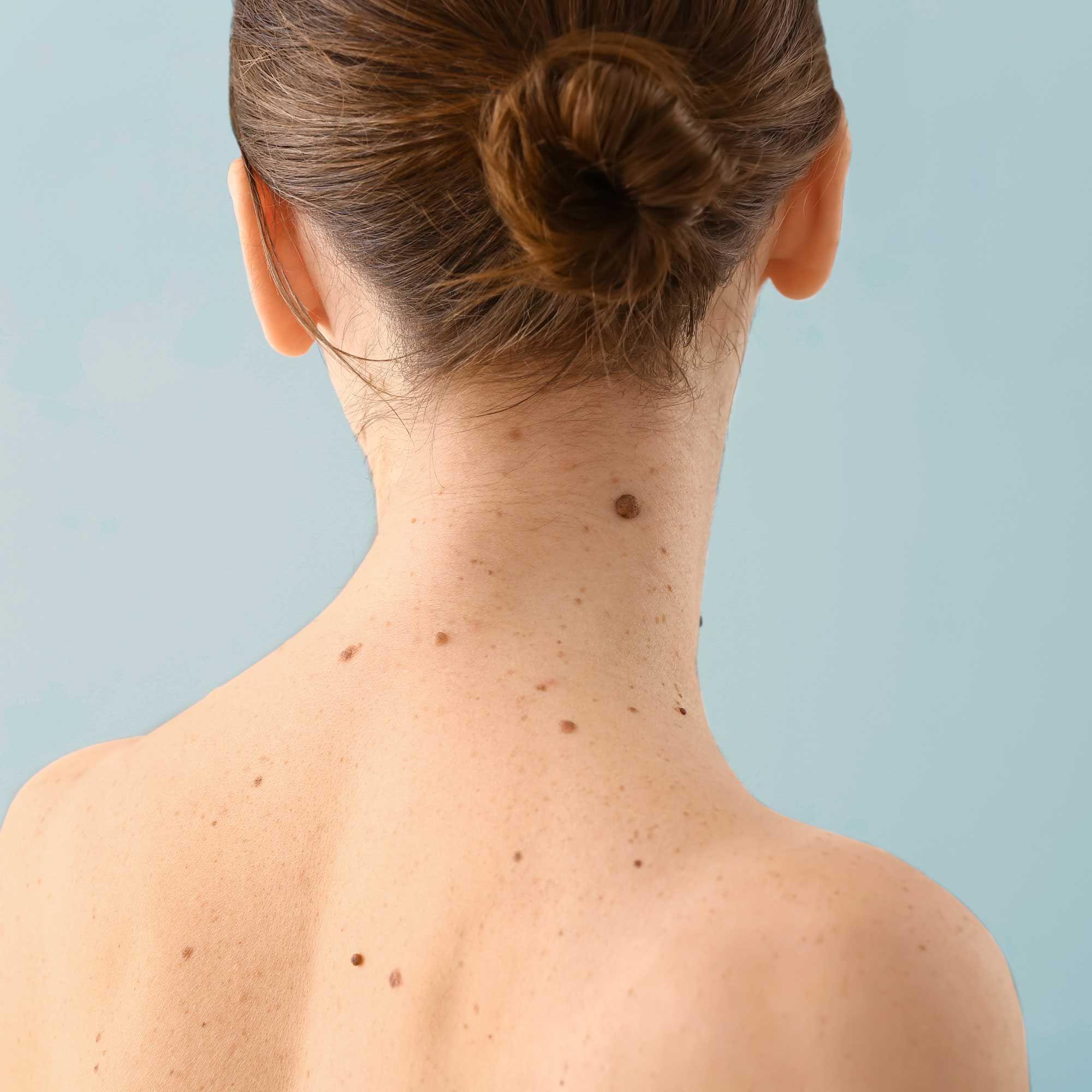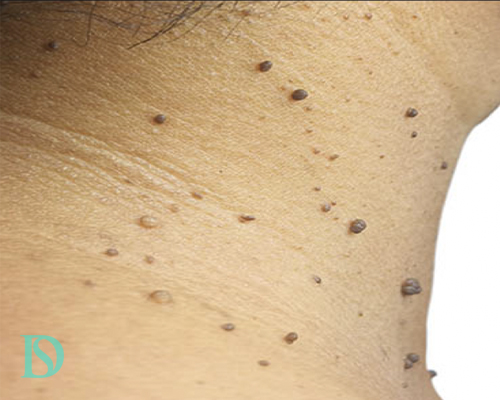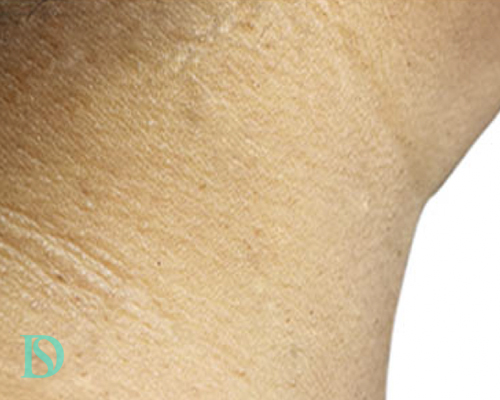Treatment at Derma Solution
Skin Tag

Skin tag removal using a plasma pen is a non-surgical technique that utilizes plasma energy to effectively remove skin tags and other benign skin lesions. Plasma pens are advanced devices that produce a high-frequency electrical arc to create a plasma beam, which is used to treat the skin. Here’s an overview of how the plasma pen works for skin tag removal, its benefits, and what to expect from the procedure:
How Plasma Pen Skin Tag Removal Works
Plasma Energy:
- Device Function: The plasma pen generates a high-frequency electrical arc that ionizes the air between the pen’s tip and the skin, creating a plasma beam. This plasma energy is delivered to the skin in controlled pulses.
- Targeting: The plasma beam creates a thermal effect that targets and vaporizes the skin tag tissue while leaving the surrounding skin relatively unaffected.
Treatment Process:
- Application: The plasma pen is used to carefully treat the area around and on the skin tag. The energy causes the skin tag to shrink and eventually fall off as the treated tissue is exfoliated and natural healing occurs.
- Precision: The procedure allows for precise targeting of skin tags, minimizing damage to surrounding tissues.
Benefits of Plasma Pen Skin Tag Removal
Non-Surgical:
- Minimally Invasive: Plasma pen treatment is non-surgical and does not require incisions or stitches. It is a minimally invasive alternative to traditional surgical removal methods.
Precision:
- Targeted Removal: The plasma pen allows for precise removal of skin tags with minimal impact on the surrounding skin, reducing the risk of scarring.
Quick Recovery:
- Minimal Downtime: Recovery time is typically short. Most patients can resume normal activities shortly after the procedure, although there may be some initial redness or swelling.
Effective:
- Results: Plasma pen treatment is effective for removing various sizes of skin tags and can also be used for other skin lesions, such as age spots or small warts
Treatment Protocol
Consultation:
- Assessment: A consultation with a qualified practitioner is essential to assess the skin tags, discuss treatment goals, and determine if plasma pen treatment is suitable.
Procedure:
- Duration: The treatment is usually quick, often taking 15-30 minutes, depending on the number and size of the skin tags.
- Preparation: The area to be treated is cleansed, and a topical numbing cream may be applied to minimize discomfort during the procedure.
Post-Treatment Care:
- Aftercare: Patients should follow post-treatment care instructions, which may include keeping the area clean, avoiding sun exposure, and applying any prescribed ointments.
- Healing: The treated skin tag will typically crust over and fall off within a week or two as the area heals. It is important to avoid picking at the crusted area to prevent scarring.
Treatment Areas
- Face
- Neck
- Body
Ideal Candidates
- Benign Skin Tags: Individuals with benign skin tags or small, non-cancerous lesions are ideal candidates for plasma pen treatment.
- Non-Surgical Preference: Those seeking a non-surgical option for skin tag removal may find the plasma pen to be an effective solution.
Plasma pen treatment for skin tag removal offers a modern, non-surgical approach with several benefits, including precision, minimal downtime, and effective results. It’s important to consult with a qualified practitioner to ensure that this treatment is appropriate for your specific needs and to receive personalized care throughout the process.
Summary Treatment
Procedure Time:
Various
Back to Work:
Immediate
Anaesthetic:
topical
Sensitivity Period:
1 – 7 days
Duration of results:
Permenant
Risks and Complications:
Scarring, Redness, swelling, scabbing, pigmentation
Book Now:
Procedure Time:
Various
Back to Work:
Immediate
Anaesthetic:
None
Full Recovery:
Immediately estimated
Sensitivity Period:
None
Duration of results:
Immediately
Risks and Complications:
Scarring, especially if you suffer from keloid scarring, Skin irritation, Infection
Book Now:


Price GuaranteeOn All Treatment
Derma Solution offers a price guarantee on all of our treatment ranges. If you are able to find a treatment that we offer cheaper anywhere in Copenhagen we will match the price.
Skin Tag
Frequently Asked Questions
A plasma pen is a device that uses plasma energy to treat various skin conditions. It generates a high-frequency electrical arc that creates a plasma beam. This beam is used to target and treat specific areas of the skin, such as skin tags, by causing controlled thermal damage to the tissue.
Skin tags do not grow back after removal and can be permanently removed with treatment. However, if you are prone to skin tags in a particular area, you may get new ones which grow in the future
The plasma pen creates a plasma arc that vaporizes the skin tag tissue through a process of controlled thermal energy. The plasma energy precisely targets the skin tag, causing it to shrink and eventually fall off as the treated area heals.
Most patients experience only minimal discomfort during the procedure. A topical numbing cream is usually applied to the treatment area to help manage any pain. The sensation can be described as a mild stinging or prickling.
- Precision: The plasma pen allows for precise targeting of skin tags with minimal impact on surrounding skin.
- Non-Surgical: It is a non-invasive procedure, meaning no incisions are required.
- Minimal Downtime: Most patients can resume normal activities soon after the procedure.
- Effective: It is effective for removing various sizes and types of skin tag
The duration of the plasma pen procedure for skin tag removal is typically between 15-30 minutes, depending on the number and size of the skin tags being treated.
After the procedure, the treated area may be red and swollen. A crust or scab may form over the treated skin tag as it heals. This is a normal part of the healing process and will eventually fall off.
The skin tag usually falls off within 1-2 weeks after the treatment. The exact time can vary depending on the size of the skin tag and individual healing responses.
Potential side effects include:
- Temporary Redness: The treated area may be red and swollen for a few days.
- Crusting: A crust or scab may form over the treated skin tag.
- Sensitivity: Some mild sensitivity or discomfort may be experienced in the treated area.
- Pigmentation Changes: Rarely, there may be temporary changes in skin pigmentation.
- Keep it Clean: Gently cleanse the area with a mild cleanser.
- Avoid Picking: Do not pick at scabs or crusts as this can lead to scarring or infection.
- Sun Protection: Apply sunscreen to protect the area from sun exposure, which can cause pigmentation changes.
- Follow Instructions: Adhere to any specific aftercare instructions provided by your practitioner.
- Avoid Excessive Heat: Avoid hot baths, saunas, or strenuous exercise immediately after the treatment.
- Gentle Products: Use gentle skincare products and avoid harsh chemicals on the treated area.
- Regular Monitoring: Keep an eye on the treated area for any unusual signs or symptoms and contact your practitioner if you have concerns.
Most people are suitable candidates for plasma pen treatment; however, it may not be recommended for individuals with certain medical conditions or those who are pregnant. A consultation with a qualified practitioner will help determine if this treatment is appropriate for you.
Typically, a single treatment is sufficient for most skin tags. However, larger or multiple skin tags may require additional sessions. Your practitioner will provide guidance based on your specific case.



